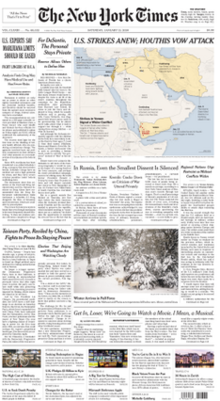Unknown Facts About News Articles
Table of ContentsFascination About News ArticlesSome Known Details About News Articles News Articles Fundamentals ExplainedNot known Facts About News ArticlesThe Ultimate Guide To News Articles
Great expertise of different subjects gives pupils an affordable side over their peers. Although electronic and social networks are easily available, we ought to not neglect how vital it is to check out the newspapers. Moms and dads have to try and instill the practice of checking out a paper as an everyday routine to proceed the legacy of the revered print tool.Information tales also include at the very least one of the following crucial features family member to the designated audience: closeness, importance, timeliness, human interest, quirk, or consequence.
Within these limits, news tales likewise intend to be thorough. Other aspects are entailed, some stylistic and some obtained from the media form. Amongst the bigger and a lot more highly regarded papers, fairness and equilibrium is a major factor in offering information. Commentary is usually restricted to a different area, though each paper might have a different total angle.
Newspapers with a worldwide target market, as an example, tend to make use of a much more official style of composing. The details choices made by an information outlet's editor or content board are often accumulated in a style guide; common style overviews consist of the and the United States News Style Book. The major goals of information writing can be summarized by the ABCs of journalism: precision, brevity, and quality.
News Articles for Beginners
Generally, journalists will not make use of a long word when a brief one will do. They use subject-verb-object building and vibrant, active prose (see Grammar). They supply anecdotes, instances and metaphors, and they hardly ever depend on generalizations or abstract concepts. Information authors try to avoid utilizing the very same word greater than once in a paragraph (sometimes called an "echo" or "word mirror").
However, headlines sometimes omit the subject (e.g., "Leaps From Watercraft, Catches in Wheel") or verb (e.g., "Cat lady fortunate"). A subhead (also subhed, sub-headline, subheading, subtitle, deck or dek) can be either a subordinate title under the main headline, or the heading of a subsection of the write-up. It is a heading that comes before the major message, or a team of paragraphs of the primary message.

Extra billboards of any of these kinds might show up later on in the short article (specifically on subsequent pages) to attract more analysis. Such signboards are likewise made use of as tips to the post in various other sections of the magazine or site, or as ads for the piece in various other magazine or sites. Typical framework with title, lead paragraph (summary in strong), various other paragraphs (information) and contact information.

Example of a hard-lead paragraph NASA is proposing an additional space task. The budget plan requests around $10 billion for the job.
The NASA news came as the company requested $10 billion of appropriations for the job. An "off-lead" is the 2nd most Continue essential front web page news of the day. The off-lead shows up either in the top left edge, or directly below the lead on the. To "hide the lead" is to start the post with history details or information of second relevance to the readers, requiring them to learn more deeply right into a post than they should have to in order to uncover the vital factors.
News Articles Things To Know Before You Get This
Typical use is that or two sentences each develop their very own paragraph. Journalists usually describe the organization or structure of a news story as an upside down pyramid. The crucial and most fascinating elements of a story are placed at the start, with sustaining information complying with in order of decreasing value.
It enables individuals to discover a subject to just the deepness that their interest takes them, and without the imposition of information or nuances that they can consider irrelevant, yet still making that information available to much more interested visitors. The upside down pyramid framework also allows short articles to be cut to any type of arbitrary length during design, to suit the area offered.
Some writers start their tales with the "1-2-3 lead", yet there are many kinds of lead available. This format invariably begins with a "Five Ws" opening paragraph (as explained above), followed by an indirect quote that offers to support a significant component of the very first paragraph, and afterwards a direct quote to support the indirect quote. [] A twist can describe several points: The last story current broadcast; a "satisfied" story to end the program.
Longer articles, such as publication cover articles and the items that lead the inside sections of a newspaper, are referred to as. Feature tales differ from straight news in numerous my company ways. Foremost is the absence of a straight-news lead, the majority of the moment. Instead of using the essence of a tale in advance, attribute writers might try to draw visitors in.
The 15-Second Trick For News Articles
A function's initial paragraphs typically relate an appealing pop over to this site moment or occasion, as in an "unscientific lead". From the details of an individual or episode, its view rapidly widens to abstract principles regarding the tale's topic.

The Editor's Tool kit: A Referral Guide for Beginners and Professionals (2001) Allan M. Siegal and William G. Connolly. The New York City Times Handbook of Design and Usage: The Official Design Overview Utilized by the Writers and Editors of the Globe's A lot of Authoritative Newspaper (2002) M. L. Stein, Susan Paterno, and R.